the 2007 Abstract Presentations - Wound Healing Society
the 2007 Abstract Presentations - Wound Healing Society
the 2007 Abstract Presentations - Wound Healing Society
Create successful ePaper yourself
Turn your PDF publications into a flip-book with our unique Google optimized e-Paper software.
<strong>Abstract</strong>s<br />
92<br />
TREATMENT OF SEVERE HIDRADENITIS SUPPURATIVA<br />
WITH EXCISION AND ENGRAFTMENT WITH A DERMAL<br />
SUBSTITUTE (INTEGRA)<br />
Roselle E. Crombie, MD/MPH, Philip E. Fidler, MD, John T. Schulz,<br />
MD/PhD<br />
Bridgeport Hospital/Yale New Haven System, Andrew J. Pannetieri Burn<br />
Unit, 267 Grant Street, Bridgeport, CT 06611<br />
Introduction: Hidradenitis supparativa is a chronic condition with significant<br />
morbidity. Despite much research, medical and surgical interventions often<br />
yield only modest improvement. Patients continue with <strong>the</strong> chronic suffering<br />
with debilitating infections and disfiguring and debilitating scarring. We<br />
present a case where complete excision nuchal Hidradenitis supparativa was<br />
engrafted with layered dermal regeneration template (Integra).<br />
Methods: JM is a 37-year-old male with a long standing history of hidradenitis<br />
to his back, bilateral axilla, bilateral antecubital fossa, nape of neck and his<br />
perineum. The full thickness skin to <strong>the</strong> subcutaneous fat was excised over <strong>the</strong><br />
nape of his neck and replaced <strong>the</strong> area with a dermal substitute (Integra)<br />
meshed 1:1 and treated with Vacuum assisted closure (VAC KCI) as a stent for<br />
24 hours and a subsequent second layer at one week, meshed 1:1 with VAC<br />
applied for 10 days. An abutting abscess was incised and drained and treated as<br />
MSSA. The graft sites were covered with anti-microbial Acticoat dressing and<br />
wound vac <strong>the</strong>rapy applied to improve graft take.<br />
Results: The patient has had good take of <strong>the</strong> dermal substitute. He is now<br />
disease free of hidradenitis in this region of his back. Given that <strong>the</strong> patient<br />
tolerated <strong>the</strong>se procedures well, we plan to apply <strong>the</strong> same treatment to o<strong>the</strong>r<br />
areas on his body with hidradenitis.<br />
Conclusions: Excision of severely affected hidradenitis and engraftment with a<br />
dermal substitute serves as a reasonable surgical option for <strong>the</strong>se patients.<br />
Given that <strong>the</strong> underlying problem lies at <strong>the</strong> level of <strong>the</strong> eccrine gland in<br />
hidradenitis, <strong>the</strong> area of excision is now free of <strong>the</strong> disease. Dermal substitute<br />
(Integra) with split thickness skin graft to this area served as an excellent means<br />
of coverage in our patient. Fur<strong>the</strong>r studies with this technique in hidradenitis<br />
needs to be done to fur<strong>the</strong>r delineate <strong>the</strong> benefits of this procedure.<br />
93<br />
MECHANISMS OF ACTION OF THE V.A.C. DEVICE IN THE<br />
DB/DB MOUSE MODEL<br />
Sandra Saja Scherer MD 1 , Giorgio Pietramaggiori MD 1,2 , Jasmine C. Ma<strong>the</strong>ws<br />
BA 1 , Dennis P. Orgill MD PhD 1<br />
1 Division of Plastic Surgery, Brigham and Women’s Hospital, Harvard<br />
Medical School,<br />
2 Division of Plastic Surgery, University of Padua, Italy<br />
The vacuum assisted closure device (V.A.C) has been used as a wound healing<br />
tool for several years. However, its mechanism of action is still poorly understood.<br />
We fragmented <strong>the</strong> V.A.C. device into its single elements and studied <strong>the</strong><br />
impact of each on healing in <strong>the</strong> diabetic mice. Full thickness skin wounds on<br />
<strong>the</strong> dorsum of db/db mice were treated for 7 days with <strong>the</strong> V.A.C. device or its<br />
single components (polyurethane sponge, sub-atmospheric pressure, or occlusive<br />
dressing alone). In addition, we studied <strong>the</strong> effects of V.A.C. application for<br />
12 hours and followed up for a total of 7 days. Dressings were changed every 48<br />
hours and standardized digital pictures were taken on days 0, 2, 4 and 7. Then,<br />
wounds were harvested. Histological cross sections were stained for H&E,<br />
PECAM-1 and Ki67 to quantify granulation tissue area, vascularization, and<br />
cell proliferation, respectively. <strong>Wound</strong>s treated with <strong>the</strong> sponge showed less<br />
contraction compared to all o<strong>the</strong>r groups. The 12-hour V.A.C. treatment<br />
showed faster wound closure starting from day 4 compared to wounds treated<br />
with <strong>the</strong> V.A.C. device for 7 days continuously. 12-hour V.A.C. treatment<br />
increased granulation tissue formation compared to <strong>the</strong> o<strong>the</strong>r groups except <strong>the</strong><br />
V.A.C. applied for 7 days. The V.A.C. treatment, both for 7 days and 12 hours,<br />
induced dramatic increases in cell proliferation compared to all o<strong>the</strong>r groups.<br />
No differences were seen in microvessel density among <strong>the</strong> groups. The V.A.C.<br />
device enhances healing mainly through increased cell proliferation. The effects<br />
of <strong>the</strong> composite device are superior to <strong>the</strong> effects of its single elements. These<br />
effects might be a cause of an early trigger ra<strong>the</strong>r than by continuous<br />
stimulation. Mechanical forces and <strong>the</strong> reduction of <strong>the</strong> wound fluid may be<br />
important in <strong>the</strong> mechanism of action of <strong>the</strong> V.A.C. device.<br />
ORAL-POSTER PRESENTATIONS:<br />
Blue Ribbon Posters<br />
Sunday, April 29, <strong>2007</strong>, 7:00 to 8:30 am<br />
<strong>Abstract</strong>s 94–102<br />
94<br />
INTRACELLULAR ATP DELIVERY CAUSES EXTREMELY<br />
FAST GRANULAR TISSUE GROWTH IN RABBITS<br />
Sufan Chien, MD, Michael Tseng, PhD, Ming Li, BS, Gordon Tobin, MD,<br />
Joseph Banis, MD<br />
Department of Surgery and Department of Anatomic Science and<br />
neurobiology, University of Louisville, Louisville, KY<br />
<strong>Wound</strong> tissue hypoxia has been known for decades, no one has studied wound<br />
high-energy phosphate metabolism. We hypo<strong>the</strong>sized that intracellular ATP<br />
delivery could enhance wound healing, and have used small unilamellar lipid<br />
vesicles (diameter 100–200 nm) to encapsulate Mg-ATP (ATP-vesicles) for<br />
intracellular delivery. The composition was: 100 mg/ml of soy PC/DOTAP<br />
(50:1), Trehalose/Soy PC (2:1), 10 mM KH2PO4, and 10 mM Mg-ATP.<br />
A rabbit ischemic ear model was created using minimally invasive surgery.<br />
Three small incisions were made on <strong>the</strong> vascular bundles about 1 cm distal to<br />
<strong>the</strong> base of one ear, and a circumferential subcutaneous tunnel was made<br />
through <strong>the</strong> incisions. The central and cranial arteries and all subcutaneous<br />
tissues, muscles and nerves were divided to <strong>the</strong> bare cartilage, leaving three<br />
veins, one artery, and <strong>the</strong> skin intact. Four wounds (6 mm diameter) were<br />
created on <strong>the</strong> ventral side of both ears. Normal saline or ATP-vesicles were<br />
used and dressings were changed daily. Ten adult rabbits were used. In <strong>the</strong><br />
wounds treated by ATP-vesicles, granular tissue started to appear only one day<br />
after surgery on <strong>the</strong> non-ischemic (control) ear. By day 4, this tissue had almost<br />
covered <strong>the</strong> whole wound area; while in <strong>the</strong> control wounds (saline only), very<br />
little granular tissue was found. A similar phenomenon occurred on <strong>the</strong><br />
ischemic ear, but with 3–4 days of delay. However, granular tissue also covered<br />
wound area almost completely on day 7 in <strong>the</strong> ATP-vesicles-treated wounds.<br />
<strong>Wound</strong>s healed faster in ATP-vesicles treated group. Histologically, this<br />
granular tissue was filled with microvasculature, and sometimes <strong>the</strong> epi<strong>the</strong>lium<br />
had to grow through <strong>the</strong> ‘‘tunnel’’ of <strong>the</strong> granular tissue. This extremely fast<br />
granular tissue growth has never been reported before, and <strong>the</strong> mechanisms for<br />
such a fast growth by ATP-vesicles are still unknown but might be related to<br />
increased tissue energy supply.<br />
95<br />
ADENOSINE A2A RECEPTOR OCCUPANCY REGULATES<br />
EXPRESSION OF MULTIPLE GENES INVOLVED IN WOUND<br />
HEALING<br />
Hailing Liu, Maria Dolores Guerrero, Patricia Fernandez, Edwin Chan and<br />
Bruce Cronstein<br />
Department of Medicine, NYU School of Medicine, New York, NY 10016<br />
Background: Four adenosine receptors have been identified: A1, A2A, A2B,<br />
and A3. Previous studies in our lab have demonstrated that CGS21680, a<br />
selective adenosine A2A receptor agonist, significantly accelerates wound healing<br />
in animals with both normal and impaired wound healing. In order to dissect<br />
<strong>the</strong> mechanisms by which <strong>the</strong> adenosine A2A receptor promotes wound healing,<br />
we analyzed mRNA from human dermal fibroblasts using array technologies.<br />
Methods: Human dermal fibroblast cells were harvested after being treated with<br />
1 mM CGS-21680 for 2, 4, 6, 8, 10 and 12 hours and total RNA was purified.<br />
After <strong>the</strong> quality of RNA was checked, Affymetrix microarray chips were used<br />
to screen mRNA levels for changes in message levels. We fur<strong>the</strong>r screened<br />
changes in mRNA expression using RT profiler TM PCR array of human growth<br />
factor and extracellular matrix and adhesion molecules. mRNA level changes<br />
were confirmed by real-time PCR compared to GAPDH as control.<br />
Results: The adenosine A2A receptor agonist CGS-21680 increased expression<br />
of <strong>the</strong> cell-cell adhesion molecule catenin D1 5 fold and cell-matrix adhesion<br />
molecule osteopontin 2.2 fold. A2A receptor occupancy also decreased ECM<br />
proteinase MMP3 and ano<strong>the</strong>r adhesion molecule catenin A1 expression by 4<br />
fold. On microarray and superarray analyses, mRNA of o<strong>the</strong>r molecules was<br />
also affected although we have not confirmed <strong>the</strong>se changes via an independent<br />
assay.<br />
Conclusion: Adenosine A2A receptors regulate <strong>the</strong> expression of molecules<br />
that are critical to wound healing like osteopontin. These receptor-induced<br />
changes in fibroblast function accelerate wound healing.<br />
<strong>Wound</strong> Rep Reg (<strong>2007</strong>) 15 A14–A54 c <strong>2007</strong> by <strong>the</strong> <strong>Wound</strong> <strong>Healing</strong> <strong>Society</strong><br />
A39


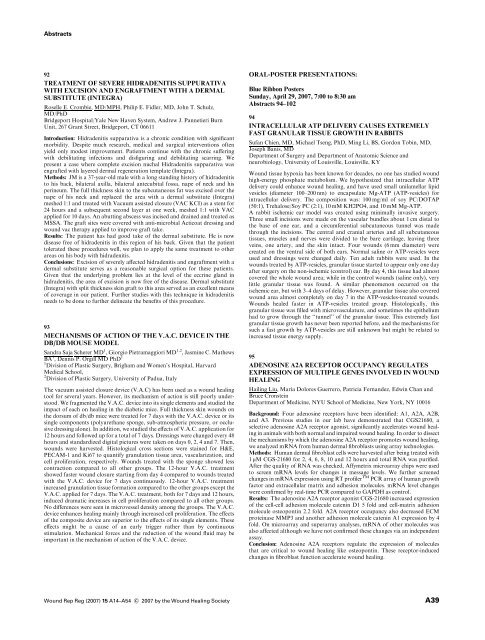

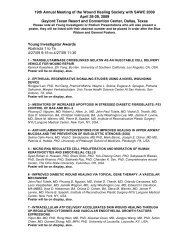

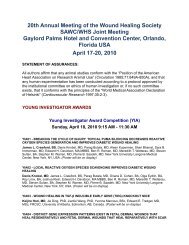
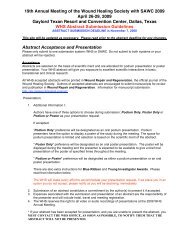
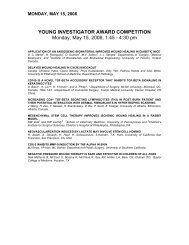



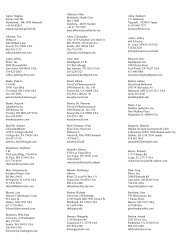
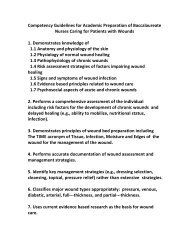
![2010 Abstracts-pah[2] - Wound Healing Society](https://img.yumpu.com/3748463/1/190x245/2010-abstracts-pah2-wound-healing-society.jpg?quality=85)